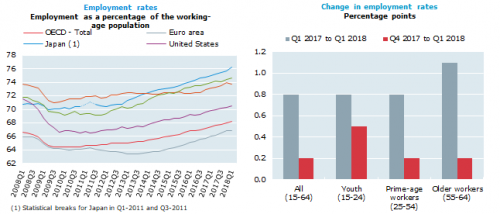OECD employment rate increases to 68.2% in the first quarter of 2018
The OECD area employment rate – the share of the working-age population with jobs – increased by 0.2 percentage point in the first quarter of 2018, to 68.2%, with gains in 28 out of 36 OECD countries. Higher employment rates occurred alongside a higher labour force participation rate, which increased by 0.1 percentage point (to 72.2%). Across the OECD area (now including Lithuania), 567 million people were employed in the first quarter of 2018.

In the euro area, the employment rate continued to rise in the first quarter of 2018 (by 0.1 percentage point, to 66.9%), albeit at a slower pace than in previous quarters. Outside the euro area, the employment rate increased most in Japan (up 0.6 percentage point, to 76.3%) and Hungary (up 0.5 percentage point, to 69.2%), while it decreased by 0.2 percentage point in Canada (to 73.7%) and by 0.4 percentage point in Iceland (to 85.2%, the highest employment rate in the OECD area). The employment rate increased by 0.3 percentage point in the United Kingdom (to 74.7%) and Mexico (to 61.4%) and by 0.2 percentage point in the United States (to 70.5%) and Turkey (to 52.5%).
The quarterly increase in the OECD employment rate benefitted all age groups but was more pronounced for young people (people aged 15 to 24, with gains of 0.5 percentage point, to 41.9%) than for prime-age workers (aged 25-54, up 0.2 percentage point, to 78.3%) and older workers (aged 55-64, up 0.2 percentage point, to 61.0%). This pattern contrasts with the one that prevailed in the recent past: compared to the previous year, the increase in the OECD employment rate was stronger for older workers than for other age groups.
Source: Organization for Economic Co-operation and Development
- 219 reads
Human Rights
Ringing FOWPAL’s Peace Bell for the World:Nobel Peace Prize Laureates’ Visions and Actions

Protecting the World’s Cultural Diversity for a Sustainable Future

The Peace Bell Resonates at the 27th Eurasian Economic Summit

Declaration of World Day of the Power of Hope Endorsed by People in 158 Nations

Puppet Show I International Friendship Day 2020

